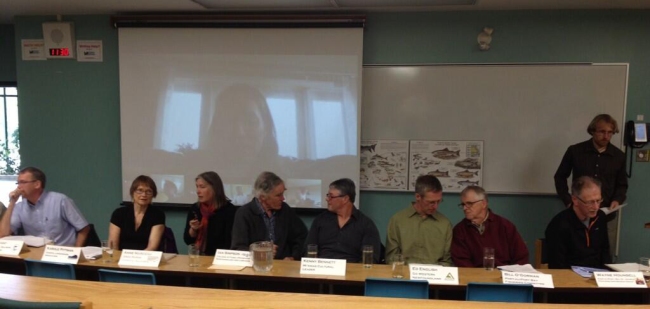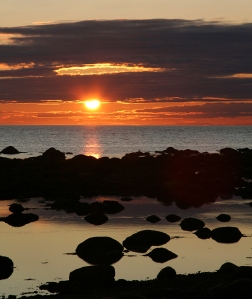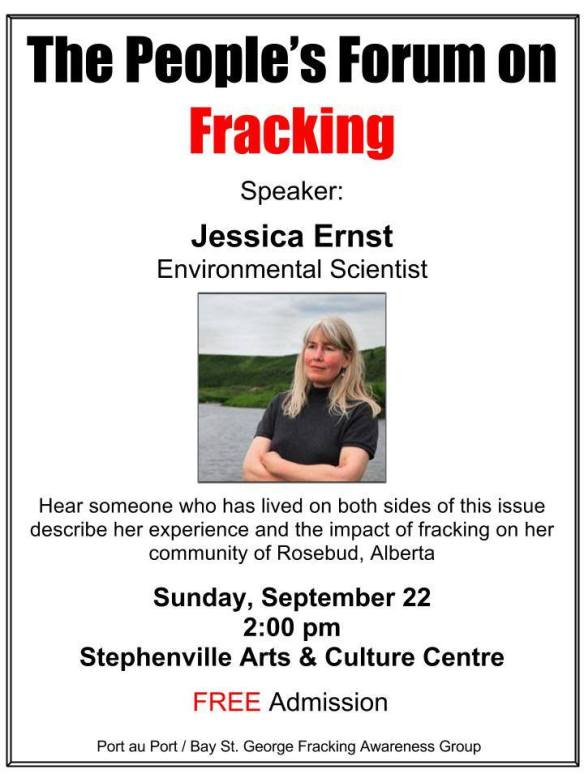New Brunswick Dec 2014 Moratorium
5 conditions before lifting moratorium and proceeding:
- A social license be established
- Clear and credible information on the impacts on air, health and water so a regulatory regime can be developed
- A plan to mitigate the impacts on public infrastructure and address issues such as waste water disposal be established
- A process be in place to fulfill the province’s obligation to consult with First Nations
- A proper royalty structure be established to ensure benefits are maximized
Nova Scotia Sept 2014 Moratorium (with limited testing and research)
Minister of Energy Andrew Younger: “This is neither a permanent nor a time-limited ban…instead, our government recognizes that the availability and understanding of the science of hydraulic fracturing in shale will evolve one way or the other.” (quoted in the Chronicle Herald, Sept. 3, 2014)
Main Recommendations of the Wheeler Report:
- Hydraulic fracturing for the purpose of unconventional gas and oil development should not proceed at the present time in Nova Scotia.
- Independent conducted research of scientific and public participatory nature is required to model economic, social, environmental, and community health impacts of all forms of energy production and use – including any prospect of unconventional gas and oil development should not proceed in Nova Scotia – at both provincial and federal levels.
- Nova Scotia should design and recognize the test of community permission to proceed before exploration occurs for the purpose of using hydraulic fracturing in the development of unconventional gas and oil resources.
In other words, The Wheeler Report stressed the need for social license and social acceptability. The report also outlined 32 recommendations to safeguard community health, local economies, ecosystem health, and the environment should the Province and communities wish to proceed with hydraulic fracturing at some point in the future.
Quebec Dec 15 2014 De Facto Moratorium
Background
The BAPE (Bureau d’audiences publiques sur l’environnement / Office for public consultation on the environment) is a Quebec neutral public body dedicated to public information and consultation on projects that could potentially have a significant impact on the environment or on any other issue related to the quality of the environment. Only certain types of projects listed in regulations are subjected to such environmental assessments and scrutiny by the BAPE. The Environment Minister has discretionary power to give the BAPE any public inquiry mandate related to any question concerning the quality of the environment.
For a comprehensive reference on issues related to oil exploration and potential impacts in the Gulf of St. Lawrence, see:
St-Lawrence Coalition. 2014. Gulf 101 Oil in the Gulf of St-Lawrence: Facts, Myths and Future Outlook. Available online at: http://www.globaliadev.com/coalitionstlaurent/Golfe101/EN/DSF_Golfe_101_English_June_4_2014_V2.pdf
Feb 2011
The first BAPE report on shale gas concluded that there was not enough scientific knowledge to determine the risks.
From May 2011 to Dec 2013 the Committee for the Strategic Environmental Evaluation on Shale Gas commissioned dozens of specific research reports. A list of the studies performed during the 31 months of the SEA are available at: http://www.bape.gouv.qc.ca/sections/mandats/gaz_de_schiste-enjeux/documents/Etudes_EES/Tableau-etudes-EES-19-fevrier-2014_BAPE.pdf
Jan 2014
The Committee for the Strategic Environmental Evaluation (SEA) released its final report.
Conclusion: Lots of questions remain unanswered especially on human health, safety and a lack of social acceptability.
Dec15 2014
Quebec released the BAPE report (review panel of experts). An English translation of Chapter 13 is available online at: http://www.bape.gouv.qc.ca/sections/rapports/publications/bape307_Chap13_ENG.pdf
Main Conclusion:
“In conclusion, because of the magnitude of potential impacts associated with shale gas industry activities in an area of populated and as sensitive as the St. Lawrence Lowlands, because also of uncertainties that subsist regarding potential impacts on water quality of aquifers and the incapacity of the industry to guarantee long-term integrity of gas wells, the review panel is of the opinion that it has not been shown that the exploration and development of shale gas in the St. Lawrence Lowlands, using the technique of hydraulic fracturing would be for the benefit of Quebec.”
Other findings include:
- All exploration and exploitation will increase Greenhouse Gas Emissions and could have an impact on air quality (locally and regionally).
- Hydraulic fracturing could have major impact on nearby communities, from polluting the air to increasing traffic and noise.
- The royalties and other financial benefits payable to Quebec would be insufficient to compensate for the social and environmental costs and externalities or to ensure financial viability for the industry. In other words, hydraulic fracturing would not be economically advantageous for Quebec.
- There is a lack of knowledge, particularly with respect to water resources.
- There is a lack of social acceptability.
In other words, three reports arrived at the same conclusion:
- Shale gas exploration and extraction in the region is not economically advantageous
- Social license / acceptability is not present
- There is a lack of knowledge
Dec16 2014
Premier Couillard is quoted as saying “There will be no shale gas development in Quebec.” “Right now, I do not see the interest in developing (the resource).”
Dec 17 2014
The Couillard government draws a line on the shale gas adventure…for the time being…reported La Presse,
Dec 19 2014
Premier Coulliard refuses to impose a moratorium: “I don’t like moratoriums because when you put a moratorium in place, you lock the door. I want to keep the doors open…”
Dec 22 2014
Gov’t of Quebec announced the information / consultation process for its Energy Policy for the Future (Future Politique Énergétique du Québec), with a report due in the Fall of 2015.
New York State Dec16 2014 Ban
After a multi-year review process, the Department of Health undertook a Health Impact Assessment. Following the release of this report, Governor Andrew Cuomo introduced a ban because of concerns over health risks and the lack of comprehensive knowledge over long-term and cumulative effects on both environmental and human health.
Dec 2014
New York State Department of Health released its report A Public Health Review of High Volume Hydraulic Fracturing for Shale Gas Development, available online at: https://www.health.ny.gov/press/reports/docs/high_volume_hydraulic_fracturing.pdf
The Review investigated impacts related to: air; water quality; seismic; communities; and human health. The Review also evaluated peer-reviewed scientific research, non-peer reviewed information, as well as gaps in knowledge.
Conclusion: The overall weight of the evidence from the cumulative body of information contained in this Public Health review demonstrates that there are significant uncertainties about the kinds of adverse health outcomes that may be associated with high volume hydraulic fracturing (HVHF).
- The dispersed nature of the activity magnifies the possibility of process and equipment failures, leading to the potential for cumulative risks for exposures and associated adverse health outcomes. Additionally, the relationships between HVHF environmental impacts and public health are complex and not fully understood. Comprehensive, long- term studies, and in particular longitudinal studies, that could contribute to the understanding of those relationships are either not yet completed or have yet to be initiated.
- While a guarantee of absolute safety is not possible, an assessment of the risk to public health must be supported by adequate scientific information to determine with confidence that the overall risk is sufficiently low to justify proceeding with HVHF in New York. The current scientific information is insufficient.
- Furthermore, it is clear from the existing literature and experience that HVHF activity has resulted in environmental impacts that are potentially adverse to public health.
Dec 11 2014
NY State health professionals and scientists released an analysis of 400 Peer-Reviewed Studies on Fracking (Towards an understanding of the environmental and public health impacts of shale gas development: an analysis of the peer-reviewed scientific literature, 2009-2014) Available online at: http://psehealthyenergy.org/site/view/1233
Key Findings:
- 96% of all studies published on health impacts indicate potential risks or adverse health outcomes.
- 87% of original research studies published on health outcomes indicate potential risks or adverse health outcomes.
- 95% of all original research studies on air quality indicate elevated concentrations of air pollutants.
- 72% of original research studies on water quality indicate potential, positive association, or actual incidence of water contamination.
Approximately 73% of all available scientific peer-reviewed papers have been published in the past 24 months.
Prince Edward Island Undecided
Minister of Environment Janice Sherry has stated that “Hydraulic fracturing is a non-issue for PEI…unless the province receives an application to drill, the province sees no need to declare whether it will ban or support the practice,” quoted in CBC news, Sept 11 2014. An environmental impact assessment would be conducted should an application be brought forward.
Newfoundland and Labrador Nov 2013 Moratorium Pending Review
Nov. 2013
The government stated it would not accept proposals for onshore and onshore to offshore exploration using hydraulic fracturing pending an Internal government review.
Oct. 2014
Minister of Natural Resources Derrick Dalley announced the composition of a five-person Panel to conduct an Independent Review of Hydraulic Fracturing for the west coast of the island of Newfoundland. A Terms of Reference for the Review was posted on the Government’s website (under News and Highlights) as well as a link to documents produced by the Government’s Internal Review: http://www.nr.gov.nl.ca/nr/energy/
As of January, 2015, the Panel has yet to announce any public consultations. Groups across the Province have questioned the composition of the Panel, its independence, and the scope as outlined in the Terms of Reference.
A geological report conducted as part of the Internal Review raises caution. It notes:
- how the Green Point Shale Formation of western Newfoundland differs from other unconventional shale reservoirs;
- that the geological complexity “carries the potential for increased risk;”
- “the potential of the Green Point shale as a suitable target for hydraulic fracturing must be fully and carefully evaluated;” and
- it is difficult to quantify the risk with the current available data.
The report is available online at: http://www.nr.gov.nl.ca/nr/energy/pdf/green_point_shale_west_nl.pdf
National
Council of Canadian Academies. 2014. Environmental Impacts of Shale Gas Extraction in Canada. Ottawa: The Expert Panel on Harnessing Science and Tehcnology to Understand the Environmental Impacts of Shale Gas Extraction. Available online at http://www.scienceadvice.ca/en/assessments/completed/shale-gas.aspx
A Panel of 14 experts and 8 review members assessed a number of environmental impacts associated with: well integrity; water (risks to groundwater and surface water, amount of water required, wastewater disposal, and management); Greenhouse Gas (GHG) Emissions; land impacts and seismic events; human health and social impacts; and monitoring, mitigation options and research.
Among the key findings, the Panel concluded that:
- Overall, the Panel found that well-targeted science is required to ensure a better understanding of the environmental impacts of shale gas development. Currently, data about environmental impacts are neither sufficient nor conclusive.
- For Canada, regional context matters. Environments, ecosystems, geographies, and geologies are not uniform across the country. Therefore, consideration of different potential regional impacts need to be closely considered when determining the suitability for shale gas development.
- Advanced technologies and practices that now exist could be effective to minimize many impacts, but it is not clear that there are technological solutions to address all of the relevant risks, and it is difficult to judge the efficacy of current regulations because of the lack of scientific monitoring.



